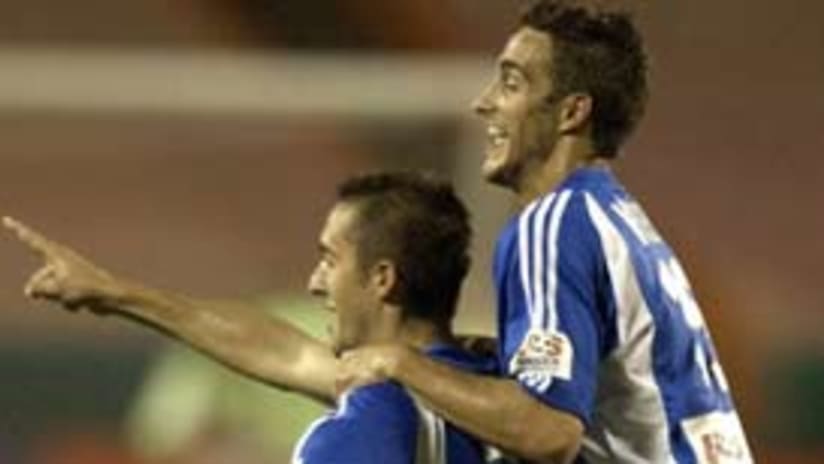actually, in the final 10 minutes alone -- they could have scored six or seven goals. Peter Vermes was playing forward for the Metros that night. By season's end, Vermes was a defender. And he was there to stay for the rest of his MLS days.
9. The spirit of '96 was, indeed, better than the current spirit. Of course, MLS was a startup and a number of people were fired up to see professional soccer games in the States. Still, I remember the first home game ever at the Rose Bowl. Early in the day, there was talk of a sellout. Of course, a sellout meant 18,000. But by game time, it was clear we were looking at something much, much greater. By halftime, 69,000 people had jammed into the Rose Bowl and another 10,000 were sent home because they needed to keep some seats empty for the postgame fireworks. The Galaxy defeated the MetroStars that night and Jorge Campos was surrounded by adoring fans as he left the field. It was, indeed, memorable. And scenes like that one were repeated often during that first season. The growing number of soccer-specific stadiums will provide a more intimate experience, and that might be enough to rekindle that electric first-season spirit.
8. The marquee in '96 has it all over the current marquee. I'm not sure what you can do about this dilemma. But one of the great strengths of early MLS was the big-name player in the center of the field. This was the point Tab made in his interview that rang most true to me. No, it wasn't true of every team. But the Galaxy had Mauricio Cienfuegos, and he got a lot of the ball. And D.C. United had Marco Etcheverry, and he defined that team. Tampa Bay, of course, had Carlos Valderrama, and everything went through him. The MetroStars would've loved for Roberto Donadoni to play a more central role, but he seemed to gravitate toward the outside of the field. Still, Donadoni was the international face of the MetroStars. As those players moved on, the league lost a little something that it never got back. That's not to say Amado Guevara is not the greatest playmaker to ever wear a Metro uniform. I think he is. But to me the marquee is just not as strong.
7. The life and times of the U.S. national team player have changed greatly since '96. A lot was made of players like Tab, Alexi Lalas, John Harkes and Wynalda, giving up their work outside the USA to come home and kick start MLS. Those guys were indeed the pioneers. But they were also guys who were heading into the final four and five years of their careers. It's difficult to compare those guys to the likes of Landon Donovan and DaMarcus Beasley, who cut their teeth in MLS as teenagers and took their games abroad after that. Do you prefer up and coming? Or do you prefer veterans? There may be no greater change in MLS than the types of American players who are the stars.
6. The excitement of the very first year of MLS can be wrapped up in three words: All-Star Game. The atmosphere at the very first MLS All-Star Game will never be duplicated. Yes, it was a doubleheader that included a "main event" of Brazil vs. the FIFA World Stars, but the MLS game was simply awesome. A gorgeous sun-drenched afternoon at a sold-out Giants Stadium. A group of New York fans not yet jaded. Most of us knew that day it was a once in a lifetime event. Still, it was special. And I imagine for a guy like Tab, who scored a brilliant goal that day, it was one of his career highlights.
5. I like parity. I wrote about it a lot last season, but to me, MLS is a lot like the middle of any great league in the world. Remove the leaders and the dregs from a league and you've got MLS, a league where every game can go either way, and a league where the home team is always expected to win. I wish more people would look at MLS parity as something positive and unique, rather than something bad.
4. I miss the Univision games. Back in '96, there was always something cool about turning on Andres Cantor on Sunday afternoons and watching the Univision match of the week. Of course, many of my Spanish-speaking friends used to tell me that Cantor and the late Norberto Longo were ripping MLS on a weekly basis. I guess what you cannot understand does not hurt you.
3. Clash and Burn? I'm a fickle guy. I hated those nicknames. And a while ago, I actually proposed in an ESPN The Magazine MLS preview that the league give all the teams more traditional nicknames like, well, FC Dallas and Real Salt Lake. But, now that I've witnessed the changing Clash to Quakes and Burn to FCD, I kind of wish these teams had stood proud to their original names. Like I said, I'm fickle.
2. In 1996, MLS teams were allowed four international players, and Green Card rules were not yet in play. From there, we pared back to three "Senior Internationals" and, this year, we go back to four. Give me the current format over the old. I like the idea of MLS coaches and GMs scanning the globe looking for young players like Carlos Ruiz and Ronnie O'Brien and not having to hold back so much. I still like the idea of making guys who've been in MLS five years count the same as Green Card players (a loyalty reward, if you will), but I like the 2K5 rules better than the original rules.
1. As we said up top, this was meant to be simply a lively debate of Old vs. New, and I'm going to cast my vote for the current MLS over the original. I will agree with Tab on how he misses the big names in the center of the field. That was fun. But, I also think Landon Donovan in '03 was as good as any player who's ever walked on an MLS field. To make MLS better in the next 10 years we're going to need more debates like this one.
Jeff Bradley is a senior writer for ESPN The Magazine. Send your comments and complaints (200 words or less, please) to Jeff at jbradleyespn2003@yahoo.com and he promises to read (but not respond to) all of them. The views and opinions expressed in this column are those of the author's, and not necessarily those of Major League Soccer or its clubs.











